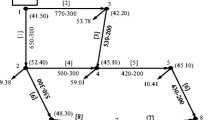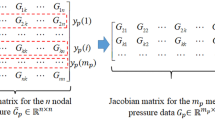Abstract
There are three methods for analysing the flow and pressure distribution in looped water supply networks (the loop method, the node method, the pipe method), accounting for the chosen unknown hydraulic parameters. For all of these methods, the nonlinear system of equations can be solved using iterative procedures (Hardy–Cross, Newton–Raphson, linear theory). In the cases of the extension or the rehabilitation of distribution networks, the unknown parameters are the hydraulic heads at nodes, and the nodal method for network analysis is preferred. In this paper, a generalised classic model is developed for the nodal analysis of complex looped systems with non-standard network components and the solvability of new problems, along with the determination of the pressure state in the system. In addition, this paper exhibits a different approach to this problem by using the variational formulation method for the development of a new analysis model based on unconditioned optimisation techniques. This model has the advantage of using a specialised optimisation algorithm, which directly minimises an objective multivariable function without constraints, implemented in a computer program. The two proposed models are compared with the classic Hardy–Cross method, and the results indicated a good performance of these models. Finally, a study is performed regarding the implications of the long-term operation of the pipe network on energy consumption using these models. The new models can serve as guidelines to supplement existing procedures of network analysis.


Similar content being viewed by others
References
Abramov NN (1972) Theory and calculation technique for water supply systems. Stroizdat, Moscow
Altman T, Boulos P (1995) Solving flow constrained networks: inverse problem. J Hydraul Eng 121(5):427–431
Andrei R, Rasturnoiu C (1980) Rare matrices and its applications. Facla Publishing House, Timisoara (in Romanian)
Arsenie DA (1983) A formula for calculation of Darcy–Weisbach friction factor. Hydrotechnics 30(12):12–19
Bhave PR (1986) Unknown pipe characteristics in Hardy–Cross method of network analysis. J Indian Water Works Assoc 18(2):133–135
Bhave PR (1990) Rules for solvability of pipe networks. J Indian Water Works Assoc 22(1):7–10
Boulos PF, Altman T, Liou JC (1993) On the solvability of water distribution networks with unknown pipe characteristics. Journal of Appl 17:380–387, Mechanical Modelling
Carlier M (1980) General and applied hydraulics. Eyrolles, Paris
Chandrasekhar M, Stewart K (1975) Sparsity oriented analysis of large pipe networks. Journal of the Hydraulics Division, ASCE 101(HY4).
Cross H (1936) Analysis of flow in network of conduits or conductors. University of Illinois Bulletin, Engineering Experiment Station 34(286):11–33
Divenot A (1980) A new method for computation of looped networks. La Houille Blanche 6:365–376
Ekinci O, Konak H (2009) An optimization strategy for water distribution networks. Water Resour Manag 23:169–185
Giustolisi O, Laucelli D, Colombo AF (2009) Deterministic versus stochastic design of water distribution networks. J Water Resour Plan Manag, ASCE 135(2):117–127
Gofman E, Rodeh M (1981) Loop equation with unknown pipe characteristics. J Hydraul Div ASCE 107(9):1047–1060
Idelchik IE (1999) Handbook of hydraulic resistance. Begell House, New York
Issacs LT, Mills KG (1980) Linear theory methods for pipe network analysis. Journal of the Hydraulics Division, ASCE 106(HY7).
Kreyszing E (1999) Advanced engineering mathematics. John Willey & Sons, New York
Krope J, Dobersek D, Goricanec D (2006) Flow pressure analysis of pipe networks with linear theory method, proceedings of the WSEAS/IASME Int. Conference on Fluid Mechanics, Miami, Florida, USA, January 18–20:59–62
Lansey KE, Ning Duan Mays LW, Yeou-Kung T (1989) Water distribution system design under uncertainties. J Water Resour Plan Manag, ASCE 115(4):630–645
Liang T (1971) Design conduit system by dynamic programming. J Hydraul Div ASCE 97(3):383–393
Martin QW (1980) Optimal design of water conveyance systems. J Hydraul Div ASCE 106(9):272–281
Nazif S, Karanouz M, Moridi A (2010) Pressure management model for urban water distribution networks. Water Resour Manag 24(3):437–458
Sarbu I (1987) Computational model of hydraulic state in complex water distribution networks. Hydrotechnics 8:309–314
Sarbu I (2010) Numerical modelling and optimizations in building services. Polytechnic Publishing House, Timisoara (in Romanian)
Sarbu I, Valea SE (2011) Analysis of looped water distribution networks using variational formulations. Metalurgia International 16(1):48–53
Shamir U, Howard CD (1970) Closure to water distribution system analysis. J Hydraul Div ASCE 96(2):577–578
Shamir U, Howard CD (1977) Engineering analysis of water distribution systems. J Am Water Works Assoc 69(9):510–514
Sharp WW, Walski TM (1988) Predicting internal roughness in water mains. J Am Water Works Assoc 80(11):34
Spiliotis M, Tsakiris G (2012) Water distribution network analysis under fuzzy demands. Civ Eng Environ Syst 29(2):107–122
Tabesh M, Asadiyani Yecta AH, Burrows R (2009) An integrated model to evaluate losses in water distribution systems. Water Resour Manag 23(3):477–492
Tanyimboh T, Tohar B, Templeman A (2003) Pressure-drive modelling of water distribution systems. Water Supply 3(1–2):255–261
Todini E, Pilati S (1988) A gradient algorithm for the analysis of pipe networks. Comput Applin Water Supply 1:1–20
Walski TM, Chase DV, Savic DA, Grayman W, Beckwith S, Koelle E (2003) Advanced water distribution modeling and management. Haestad Press, Waterbury, USA
Wood D, Rayes A (1981) Reliability of algorithms for pipe network analyses. J Hydraul Div ASCE 107(10):982–991
Yang KP, Liang T, Wu IP (1975) Design of conduit system with diverging branches. J Hydraul Div ASCE 101(1):167–188
Author information
Authors and Affiliations
Corresponding author
Rights and permissions
About this article
Cite this article
Sarbu, I. Nodal Analysis of Urban Water Distribution Networks. Water Resour Manage 28, 3143–3159 (2014). https://doi.org/10.1007/s11269-014-0660-9
Received:
Accepted:
Published:
Issue Date:
DOI: https://doi.org/10.1007/s11269-014-0660-9




